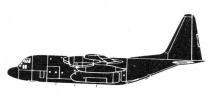Incident Overview

Description
The Atlantic Cargo Lockheed L-188C Electra departed from runway 25 at Berlin-Schnefeld Airport in Germany on a cargo flight to Cologne. As the aircraft climbed through Flight Level (FL) 60, the ground engineer came back to the cockpit and informed the commander that there appeared to be ‘smoke’ in the cargo compartment. The crew checked the appropriate systems, but detected no warnings. On this aircraft, the ‘cargo smoke’ warning light was immediately adjacent to the ‘cargo door open’ warning light located in front of the first officer. Shortly afterwards, as the aircraft was passing FL115, with the ground engineer in the cockpit and the cockpit door shut, there was an explosive decompression. The cockpit door detached from its hinges and the cockpit filled with fine debris. The aircraft rolled right, pitched down and the crew were immediately conscious of significant airframe vibration. With the aircraft in cloud, the commander regained level flight using minimum and gentle control inputs. As he did so, the other crew members were making a thorough check of the aircraft systems. The only apparent problem was the loss of aircraft pressurisation, but the commander was concerned about structural integrity. He therefore instructed the first officer to ask for radar vectors and a priority return to Schnefeld, and then commenced a shallow turn back towards the airfield. As the flight crew were carrying out these actions, the ground engineer went back to the cargo compartment to ascertain what damage had occurred. There was cargo positioned close to the cargo door but the engineer was able to see daylight where the door should have been. As he got closer, he could see the doorjacks still connected between the frame and the door, and estimated that the door was then open by approximately one foot. However, after moving closer to the open door, he became aware that the door jacks and door were no longer visible. From his position, he could partly see the left stabiliser and observed no obvious signs of damage. He then returned to the cockpit and reported to the commander that the cargo door was open. By this time, the commander had established on track to Schnefeld 180 kt. The vibration, although still significant, had reduced slightly. ATC offered the crew radar vectors for an approach to runway 25 but taking into account the light surface wind the crew requested, and were granted, the more expeditious approach to runway 07. For the recovery, the normal checks were completed apart from the decision to use less than full flap. This was selected gradually and at 78% flap, speed was reduced to 150 kt and the landing gear was lowered. With no control problems evident in this configuration, the commander decided to use 78% flap for landing and the appropriate threshold speeds were calculated. The subsequent landing on runway 07 was uneventful and the cargo door swung back into view as the speed reduced on the runway. Subsequent enquiries revealed that the cargo door was closed by a member of the airport ground staff. He was certain that the door had been correctly closed and that the adjacent external ‘door unlocked’ warning light had gone out. Examination of the aircraft showed that the door had not been fully latched at the time of departure, i.e. the seven tapered shoot-bolts were only partly engaged. The hoop loading due to pressurisation had become sufficient, as the aircraft climbed, to effectively ‘guillotine-off’ the small diameter ends of the bolts and thus release the door.
Primary Cause
Loss of aircraft pressurisation, likely exacerbated by the cargo door detachment and subsequent debris entry.Loss of aircraft pressurisation, likely exacerbated by the cargo door detachment and subsequent debris entry.Share on:





